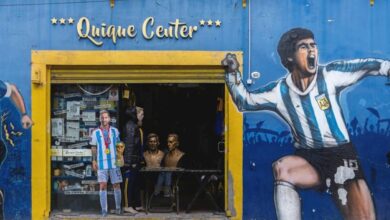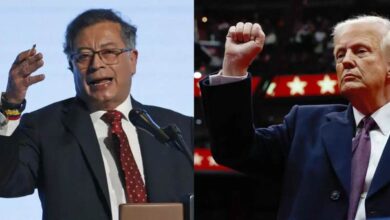Several surveys measure the approval of the leaders. Who are the best and worst qualified?

Photos: TW-petrogustavo, TW-alferdez
LatinAmerican Post | David Rivadeneira Soto
Listen to this article
Leer en español: Los presidentes latinoamericanos con mejor y peor aprobación en 2022
Regardless of their ideological stance, presidents are permanently in the eye of public opinion due to their actions or omissions . They are always being measured, so their approval is in constant flux. Although it is clear that the polls are the photograph of a moment and that the circumstances of the dynamics of political activity are changing, they show the perception of the citizenry about the performance of the leaders.
The most recent polls are, on the one hand, the poll carried out by the CID Gallup firm, which was published in mid-October. On the other hand, there is the Ranking of image and presidential approval carried out by the Legislative Directorate, an independent organization made up of academics and journalists that work for access to public information.
The Three Presidents Who Do Best in Approval
The firm CID Gallup focused on taking the pulse of the perception of the performance of the presidents in its survey, which at the same time is the most complete, since it analyzes 13 presidents of the region. While the scope of the Legislative Directory report is narrowed down to just eight of the Latin American nations, looking at the approval status of leaders by computing different metrics throughout the year.
The first president on the Gallup list is Nayib Bukele, president of El Salvador, with an approval rating of 86%, a figure that makes him the most popular in the entire neighborhood. In another study, according to the results of the Ranking of image and presidential approval, the first place is occupied by Andrés Manuel López Obrador, Mexican president, with 59% favorability.
In that same list, the order of approval is followed by Colombian President Gustavo Petro, in second place with 54% and in third position is Luis Arce, President of Bolivia, with 50% favorability ratings. Meanwhile, in the CID Gallup survey, the second and third place are occupied by Rodrigo Chávez, from Costa Rica, with 81% and the president of the Dominican Republic, Luis Abinader, who reaches 68% favorability on the Caribbean island.
Also read: How Much Should The Salary Increase After A Year Of Inflation?
The Worst Qualified in the Region
Regarding the worst approval and performance rates among the region's leaders, it is necessary to point out that this measurement was carried out weeks ago, before the dismissal of Pedro Castillo in Peru. Therefore, in both surveys the ousted former Peruvian president coincides among the first three places with the worst rating, occupying, in both surveys, the second row.
For Gallup, the worst qualified president in the citizen perception of performance is the president of Ecuador, Guillermo Lasso, who barely reaches a 17% approval rating for his work. He is followed by Pedro Castillo, who, as already indicated, was still the president in Peru, with barely 18%; and in third place Laurentino Cortizo, president of Panama, with a 20% rating. The current scenario of political convulsion that Peruvians are experiencing does not make it possible to accurately measure the perception of Dina Boluarte, the vice president, who took office as president before Congress. The protests have divided the country.
According to the Presidential Image and Approval Ranking, the worst qualified is the head of the Argentine executive Alberto Fernández, who reaches 68% disapproval of his mandate. He is followed, very closely, by the then president and now imprisoned Pedro Castillo with 67% and in third place Gabriel Boric, the young president of Chile, with 59% against his management.
What Are Their Positions?
Nayib Bukele
The young president of El Salvador has known how to win the favor of the citizenry. Among the reasons, according to the New York Times, the main one is his strong hand against gangs, after declaring a state of emergency eight months ago to confront them. However, he has been questioned by the international community for his methods to fight crime, violating human rights, and for his attacks on press freedom, as the newspaper El Colombiano points out.
Rodrigo Chavez
The news outlet NTN24 affirms that the Costa Rican remains the second most popular leader in the eyes of public opinion, despite the lack of specificity in his proposals. They describe him as a leader with a confrontational style and who acquired a good impression among voters for presenting himself as an outsider from the traditional politics of his country who came to bring order to the presidency.
Luis Abinader
This president represented the change in the Dominican government, after it had been in the hands of the Dominican Liberation Party (PLD) for 16 years, the newspaper El Colombiano reported. According to the political analysis of Candido Mercedes, for the Dominican outlet Acento.com, the high esteem in which the citizens hold the president is favored by his ability to work; the harvest of an image of a one-man orchestra that is in all government affairs.
William Lasso
The economic media Portafolio points out that one of the aspects in which the citizens rate the president's management poorly is that of citizen security. Likewise, public investment, housing management and the fight against corruption are other areas in which the president is poorly qualified by Ecuadorians, who had turned to the right with the election of this businessman.
Laurentino Cortizo
For the Costa Rican newspaper El País, Cortizo's unpopularity at the head of the executive in Panama is due to his lack of execution of the government plan after three years in power. According to the newspaper's analysis, this is due to a lack of political will, his own party and the restraint of business and political sectors to which the president owes commitment.




